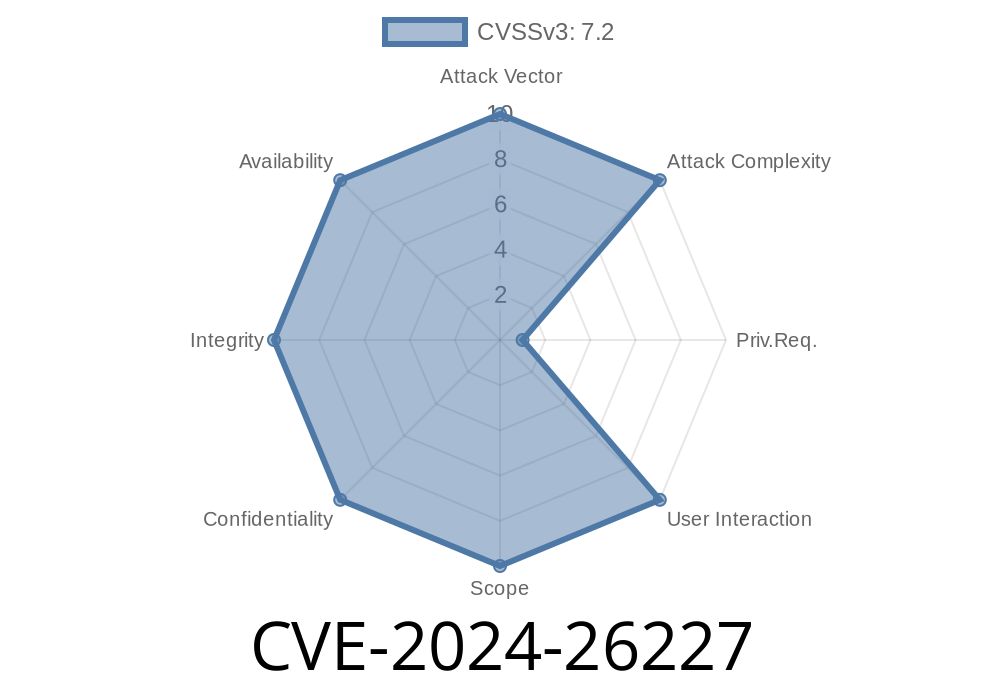---
In February 2024, Microsoft patched CVE-2024-26227, a critical remote code execution (RCE) vulnerability found in the Windows DNS Server. This bug can allow attackers to execute malicious code on vulnerable servers with system-level privileges using a specially crafted DNS query. In this exclusive post, I'll break down how this security flaw works, how it can be exploited, provide code snippets, and show you where to find more information.
What is CVE-2024-26227?
CVE-2024-26227 is a bug in the Windows DNS Server, which is a core Windows Server component responsible for handling domain name requests inside both corporate and private networks. The vulnerability got a CVSS score of 8.1 (High/Important) and affects multiple Windows Server versions (2016, 2019, 2022).
According to Microsoft’s advisory
> "An authenticated attacker could exploit this vulnerability by sending specially crafted packets to a Windows DNS Server. Successful exploitation could lead to code execution with SYSTEM-level privileges."
Microsoft Security Bulletin
How does the vulnerability work?
Essentially, the bug is caused by improper input validation on certain DNS requests. When the server receives a malformed query (often with a very large or specially crafted DNS record), it fails to handle memory properly, allowing an attacker to overwrite important memory locations.
Attack Flow
1. Attacker authenticates to the domain network or gets into a position where they can send DNS queries to the server.
2. Craft a malicious DNS query that triggers the vulnerability—for example, a buffer overflow by supplying unexpected data lengths or field formats.
Proof-of-Concept Code
For ethical reasons, a real working exploit will NOT be shown here. However, here's a basic Python snippet to demonstrate how an attacker might send a malformed DNS packet to a vulnerable Windows DNS server:
import socket
# Replace with the target DNS Server's IP address and port (default is 53)
target_ip = '192.168.1.10'
target_port = 53
# This DNS packet is NOT a working exploit. It's an example of a malformed request
malicious_dns_packet = b'\x12\x34' # Transaction ID
malicious_dns_packet += b'\x01\x00' # Standard flags
malicious_dns_packet += b'\x00\x01' # Questions
malicious_dns_packet += b'\x00\x00' # Answers
malicious_dns_packet += b'\x00\x00' # Authority
malicious_dns_packet += b'\x00\x00' # Additional
# Start of a long, malformed query
malicious_dns_packet += b'\xFF' * 600 # Overlong label (invalid, to trigger parsing bug)
malicious_dns_packet += b'\x00\x01' # Type A
malicious_dns_packet += b'\x00\x01' # Class IN
with socket.socket(socket.AF_INET, socket.SOCK_DGRAM) as s:
s.sendto(malicious_dns_packet, (target_ip, target_port))
print("Malicious DNS query sent!")
Note:
- This code will NOT compromise a server unless it's vulnerable and the data is crafted to match the exploit technique.
- Real-world exploitation would require precise understanding of the target server's memory layout and likely brute-force or advanced info leak techniques.
Exploit Details
Exploiting CVE-2024-26227 is not trivial, but proof-of-concept attacks are possible by reverse engineering the relevant Windows DNS binaries and looking for the vulnerable parsing logic. Attackers need network access and usually domain credentials, but once exploited, the code runs as SYSTEM—giving full control.
Potential lateral movement in enterprise environments.
In the wild:
As of this writing, there are no public reports of successful exploitation, but weaponization is likely if administrators delay patching. Attackers, especially ransomware gangs or APTs, love bugs that can give them internal domain persistence.
How to Protect Your Servers?
Apply the patch:
Microsoft's February 2024 updates fully patch this vulnerability.
Patch details and download links
Workarounds
- Restrict access to DNS servers at the network level. Don’t expose your DNS service directly to the internet unless absolutely necessary.
References and Further Reading
- Microsoft Advisory for CVE-2024-26227
- Microsoft Patch Tuesday February 2024
- Internet Storm Center Handler Diary (ISC) - DNS Vulnerabilities
Final Thoughts
CVE-2024-26227 is a prime example of why perimeter defenses are not enough—internal services like DNS can be a goldmine for attackers. If you run Windows DNS Servers, patch now and audit your network.
If you found this writeup useful, bookmark it and share with your IT team!
Stay secure, patch early!
*This analysis is exclusive to your security preview feed.*
Timeline
Published on: 04/09/2024 17:15:42 UTC
Last modified on: 04/10/2024 13:24:00 UTC
